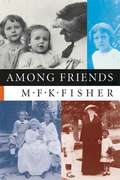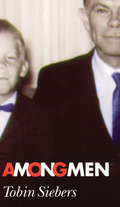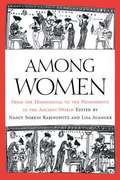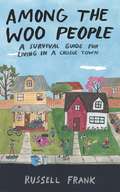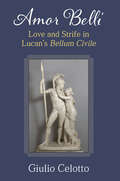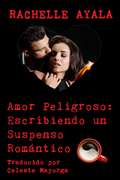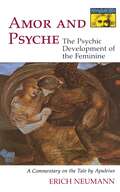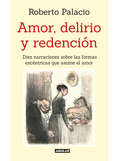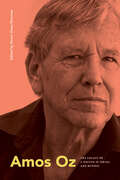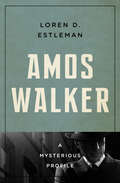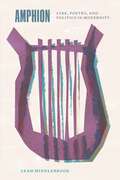- Table View
- List View
Among Friends
by M. F. K. Fisher"Among Friends," is M.F.K. Fisher's fascinating memoir of her childhood in Whittier, California. In sharing these memorable and moving portraits of her family and of the town, we are given an enchanting glimpse into the early life of one of our most delightful and best-loved writers.
Among Men
by Tobin Siebers"The tone is personal, the subject matter timely and contemporary. At turns moving, funny, poignant, and haunting, Among Men is an insightful diary about talking man to man."—Voice Literary Supplement
Among Women: From the Homosocial to the Homoerotic in the Ancient World
by Lisa Auanger Nancy Sorkin RabinowitzWomen's and men's worlds were largely separate in ancient Mediterranean societies, and, in consequence, many women's deepest personal relationships were with other women. Yet relatively little scholarly or popular attention has focused on women's relationships in antiquity, in contrast to recent interest in the relationships between men in ancient Greece and Rome. The essays in this book seek to close this gap by exploring a wide variety of textual and archaeological evidence for women's homosocial and homoerotic relationships from prehistoric Greece to fifth-century CE Egypt.<P> Drawing on developments in feminist theory, gay and lesbian studies, and queer theory, as well as traditional textual and art historical methods, the contributors to this volume examine representations of women's lives with other women, their friendships, and sexual subjectivity. They present new interpretations of the evidence offered by the literary works of Sappho, Ovid, and Lucian; Bronze Age frescoes and Greek vase painting, funerary reliefs, and other artistic representations; and Egyptian legal documents.
Among the Woo People: A Survival Guide for Living in a College Town (Keystone Books)
by Russell FrankIn the mid-nineties, Russell Frank left a peaceful life in rural California to raise three kids in a town saturated with fraternities, late-night undergrad fast food haunts, and rowdy football crowds. Among the Woo People recounts his two decades living—and surviving—in State College, Pennsylvania, the often-chaotic home of Penn State University.This humorous peek at life in a college town smack-dab in the middle of rural Pennsylvania chronicles a changing community over the course of two eventful decades. A professor of journalism, former columnist for the Centre Daily Times, and contributor to StateCollege.com, Frank has a unique perspective on living in the shadow of a university—especially on the tribe of nomadic young adults known as the “Woo people,” so named for their signature mode of celebratory communication. He invites readers into the routines of his hectic household as they embrace their new home, skewers the culture of intercollegiate sports, relates the challenges and peculiarities of teaching at one of the nation’s largest universities, and, most important, teaches us to be amused at college-kid antics and to appreciate their academic and real-world accomplishments, even as we anxiously tick off the days until semester’s end.From tales of missing porch furniture and red plastic cups in the bushes to a “Nude Year’s Eve” run by an octet of forty-somethings to the sweet relief of summer, Frank’s hilarious, insightful essays are indispensable for anyone who wants to survive, appreciate, and enjoy college-town life.
Amor Belli: Love and Strife in Lucan's Bellum Civile
by Giulio CelottoCompelled by the emperor Nero to commit suicide at age 25 after writing uncomplimentary poems, Latin poet Lucan nevertheless left behind a significant body of work, including the Bellum Civile (Civil War). Sometimes also called the Pharsalia, this epic describes the war between Julius Caesar and Pompey.Author Giulio Celotto provides an interpretation of this civil war based on the examination of an aspect completely neglected by previous scholarship: Lucan’s literary adaptation of the cosmological dialectic of Love and Strife. According to a reading that has found favor over the last three decades, the poem is an unconventional epic that does not conform to Aristotelian norms: Lucan composes a poem characterized by fragmentation and disorder, lacking a conventional teleology, and whose narrative flow is constantly delayed. Celotto’s study challenges this interpretation by illustrating how Lucan invokes imagery of cosmic dissolution, but without altogether obliterating epic norms. The poem transforms them from within, condemning the establishment of the Principate and the Julio-Claudian dynasty.
Amor Peligroso: Escribiendo un Suspenso Romántico
by Rachelle Ayala¿Estás interesado en escribir un suspenso romántico emocionante, pero no estás seguro de cómo empezar? ¿Te encanta leer novelas románticas de suspenso y te preguntas cómo se componen? El suspenso romántico es uno de los subgéneros más populares del romance y atrae a lectores tanto hombres como mujeres. Sin embargo, no es fácil combinar una relación romántica fuerte y convincente con la intriga y el suspenso de un thriller bien elaborado. En este libro, aprenderás: Los elementos esperados de un romance. Los elementos esperados en suspenso. Los diferentes tipos de héroes y heroínas y cómo evitar la situación de Muy Estúpido para Vivir. Cómo diseñar un villano digno. Los ocho tipos básicos de tramas de suspenso romántico. Cómo combinar elementos de una historia romántica y de suspenso de manera orgánica Cuándo y dónde coreografiar escenas románticas y sexys entre el ritmo vertiginoso de la acción y el peligro. ¿Cómo iniciar un suspenso romántico, con el lindo encuentro o el crimen? Cómo estructurar y desarrollar cada uno de los ocho tipos de tramas de suspenso romántico. •El Protector •La Investigación •La Persecución •La Misión •El Secreto •El Inframundo •El Cazado •El Perturbado Cómo planear y escribir una serie de suspenso romántico. Dificultades y No-Nos, o al menos piénsalo dos veces. Lectura recomendada para cada tipo de trama. Llevo escribiendo más de diez años y actualmente he escrito y publicado más de sesenta romances y novelas de suspenso romántico. Aprendí todo lo que pude sobre la estructura de la historia, la escritura de romances y la lectura de suspenso y misterio; sin embargo, fue difícil encontrar libros o cursos sobre escritura de suspenso romántico. Po
Amor and Psyche: The Psychic Development of the Feminine: A Commentary on the Tale by Apuleius. (Mythos Series) (Bollingen Series #687)
by Erich NeumannThe renowned tale of Amor and Psyche, from Apuleius's second-century Latin novel The Golden Ass, is one of the most charming fragments of classical literature. Neumann chose it as the exemplar of an unusual study of feminine psychology. Unfolding the spiritual and mythical background of the pagan narrative, he shows how the contest between the mortal maid Psyche and the great goddess Aphrodite over the god Amor--Aphrodite's son, Psyche's husband--yields surprising and valuable insights into the psychic life of women.
Amor belli: Love and Strife in Lucan’s Bellum civile
by Giulio CelottoCompelled by the emperor Nero to commit suicide at age 25 after writing uncomplimentary poems, Latin poet Lucan nevertheless left behind a significant body of work, including the Bellum Civile (Civil War). Sometimes also called the Pharsalia, this epic describes the war between Julius Caesar and Pompey.Author Giulio Celotto provides an interpretation of this civil war based on the examination of an aspect completely neglected by previous scholarship: Lucan’s literary adaptation of the cosmological dialectic of Love and Strife. According to a reading that has found favor over the last three decades, the poem is an unconventional epic that does not conform to Aristotelian norms: Lucan composes a poem characterized by fragmentation and disorder, lacking a conventional teleology, and whose narrative flow is constantly delayed. Celotto’s study challenges this interpretation by illustrating how Lucan invokes imagery of cosmic dissolution, but without altogether obliterating epic norms. The poem transforms them from within, condemning the establishment of the Principate and the Julio-Claudian dynasty.
Amor, delirio y redención
by Jorge Roberto Palacio"El viaje termina cuando los amantes se encuentran".- Verso cantado por un payaso de la obra Doceava Noche de William Shakespeare,Acto II, Escena III En este libro Roberto Palacio busca, a partir de narraciones que combinan eventos de su vida, la historia universal y la reflexión aguda sobre el tema, responderse preguntas como ¿Por qué el amor es tan difícil? ¿Por qué las relaciones íntimas tienen tantos altibajos y cada vez se hace más complejo llegar al anhelado hasta que la muerte los separe? Ese es el tema de este libro; amores torpes, iracundos, tiránicos, bañados en el dinero, rotos por la vida misma o la falta de pericia de los amantes.Lejos de ser un ensayo, Amor, delirio y redención es un relato de historias de la vida real que invitan a repensar las relaciones amorosas tal y como las conocemos e incluso a perder las esperanzas no tanto en el amor, como en las versiones románticas que nos hacemos de él, responsables de que hoy sintamos nuestras vidas marcados no por un gran amor, sino por una gran propensión a fracasar en las lides del querer."En este libro Palacio se quita el cinturón de seguridad y se asoma corajudo a esa estupidez necesaria, incluso deseable, que conocemos como amor romántico, una dolencia comparada por Ambrose Bierce con la peor de las caries".-Andrés Felipe Solano
Amos Oz: The Legacy of a Writer in Israel and Beyond (SUNY series in Contemporary Jewish Literature and Culture)
by Ranen Omer-ShermanThe veteran contributors to this volume take as their central drama, and their essential task for analysis, the enduring literary and political legacy of Israel Prize laureate Amos Oz (1939–2019). Born a decade prior to the establishment of the state of Israel, in what was then Palestine under British rule, Oz's life spanned the country's entire history, and both his fiction and nonfiction restlessly probe and illuminate its fraught conflicts, contradictions, and ambivalences. Throughout his career, Oz grappled frankly with the often-painful realities of Israeli life while also celebrating the ebullience of the Israeli spirit, and his sophisticated understanding of the sociopolitical turmoil of his society was always accompanied by intensely lyrical language and deep penetrations into the vulnerabilities of the human psyche. The volume's twenty contributors bring an exciting diversity of concerns and perspectives to Oz's most celebrated novels (including his powerfully resonant final novel, Judas) as well as to overlooked facets of his oeuvre, illuminating the breathtaking scope of his literary legacy. Together, they offer gripping analyses of his urgent and profoundly universal works about political and romantic dreamers whose heartfelt struggles with both their own human frailties and those of the state ultimately resonate far beyond Israel itself.
Amos Walker: A Mysterious Profile (Mysterious Profiles)
by Loren D. EstlemanThe four-time Shamus Award–winning author takes his readers behind-the-scenes of his long running detective series. In 1980, readers first encountered hard-boiled private detective Amos Walker as he searches for an ex-mobster&’s missing daughter in Motor City Blue. Many mysteries and decades later, the investigator is still scuffling with bad guys on the streets of Detroit. But when and where did award-winning author Loren D. Estleman conceive the idea of Walker and his adventures? In this essay, Estleman tells the story of how Walker and his world transpired. From the 1975 film that inspired the character to Walker&’s weapons and cars, Estleman offers fans a look into his process of fleshing out Walker as a complex character with friends and enemies. Learn how television influenced him as a writer and how he chose Walker&’s name, hometown, and background. Fans looking to get to know their favorite tough-guy detective better won&’t want to miss this . . . Praise for Loren D. Estleman and the Amos Walker series &“A touchstone for fans of hard-boiled crime fiction: irrepressible tough-guy dialogue, great plotting, a vibrant Detroit milieu, and a hero who has whiskey on his breath and nicotine stains on his fingers.&” —Booklist &“For readers who can&’t get enough of Elmore Leonard and Ross Thomas, try Estleman. He&’s that good.&” —People &“Estleman&’s latest intricate and wholly enjoyable yarn is peppered with mob lore, Detroit history, and the ever-present one-liners. It&’s sure to please fans of urban mysteries as well as classic detective genre devotees. Strongly recommended.&” ―Library Journal &“Amos Walker, the throwback private eye who operates out of Detroit in Loren D. Estleman&’s hard-boiled mysteries, is a lot like the old Cutlass he drives. The guy may look beat up, but under the hood he's a clean machine.&” ―The New York Times Book Review
Amphion: Lyre, Poetry, and Politics in Modernity (Thinking Literature)
by Leah MiddlebrookA reintroduction to the myth of Amphion, recovering an overlooked sphere of lyric tradition. Amphion is the figure in Greek mythology who played so skillfully on a lyre that stones moved of their own accord to build walls for Thebes. While Amphion still presides over music and architecture, he was once fundamental to the concept of lyric poetry. Amphion figured the human power to inspire action, creating and undoing polities by means of language. In contrast to the individual inspiration we associate with the better-known Orpheus, Amphion represents the relentless, often violent, play of harmony and disorder in human social life. In this wide-ranging study, Leah Middlebrook introduces readers to Amphion-inspired poetics and lyrics and traces the tradition of the Amphionic from the Renaissance through modernist and postmodern poetry and translation from the Hispanic, Anglophone, French, Italian, and ancient Roman worlds. Amphion makes a significant contribution to scholarship on the connection between poetry and politics and the history of the lyric, offering an account well-suited to our times.
Amplify Core Knowledge Language Arts, Cursive, Activity Book
by Amplify Core FoundationAmplify Core Knowledge Language Arts, Cursive, Activity Book
Amplify Core Knowledge Language Arts, Grade 1, Fables, Skills 3 Reader
by Amplify Core FoundationAmplify Core Knowledge Language Arts, Grade 1, Fables, Skills 3 Reader
Amplify Core Knowledge Language Arts, Grade 1, Grace, Skills 6 Reader
by Amplify Core FoundationAmplify Core Knowledge Language Arts, Grade 1, Grace, Skills 6 Reader
Amplify Core Knowledge Language Arts, Grade 1, Gran, Skills 2 Reader
by Amplify Core FoundationAmplify Core Knowledge Language Arts, Grade 1, Gran, Skills 2 Reader
Amplify Core Knowledge Language Arts, Grade 1, Kay and Martez, Skills 7 Reader
by Amplify Core FoundationAmplify Core Knowledge Language Arts, Grade 1, Kay and Martez, Skills 7 Reader
Amplify Core Knowledge Language Arts, Grade 1, Knowledge 1-6, Activity Book
by Amplify Core FoundationAmplify Core Knowledge Language Arts, Grade 1, Knowledge 1-6, Activity Book
Amplify Core Knowledge Language Arts, Grade 1, Knowledge, Domains 7-11, Activity Book
by Amplify Core FoundationAmplify Core Knowledge Language Arts, Grade 1, Knowledge, Domains 7-11, Activity Book
Amplify Core Knowledge Language Arts, Grade 1, Skills 1 Activity Book
by Amplify Core FoundationAmplify Core Knowledge Language Arts, Grade 1, Skills 1 Activity Book
Amplify Core Knowledge Language Arts, Grade 1, Skills 1, Snap Shots, Reader
by Amplify Core FoundationAmplify Core Knowledge Language Arts, Grade 1, Skills 1, Snap Shots, Reader
Amplify Core Knowledge Language Arts, Grade 1, Skills 2 Activity Book
by Amplify Core FoundationAmplify Core Knowledge Language Arts, Grade 1, Skills 2 Activity Book
Amplify Core Knowledge Language Arts, Grade 1, Skills 3 Activity Book
by Amplify Core FoundationAmplify Core Knowledge Language Arts, Grade 1, Skills 3 Activity Book
Amplify Core Knowledge Language Arts, Grade 1, Skills 4 Activity Book
by Amplify Core FoundationAmplify Core Knowledge Language Arts, Grade 1, Skills 4 Activity Book
Amplify Core Knowledge Language Arts, Grade 1, Skills 4, Green Fern Zoo, Reader
by Amplify Core FoundationAmplify Core Knowledge Language Arts, Grade 1, Skills 4, Green Fern Zoo, Reader
